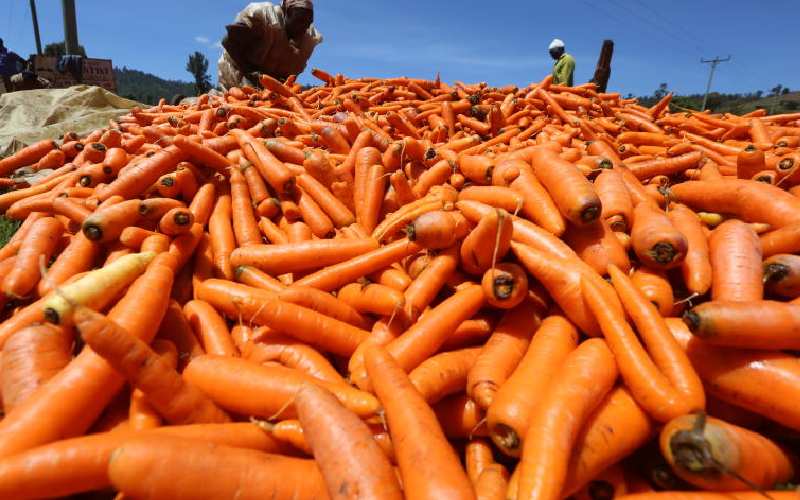
Mary Nyambura washing carrots at Mauche, Njoro, Nakuru.[Joseph Kipsang, Standard]
Carrots are a popular root vegetable which are increasingly becoming valued among smallholder farmers and consumers.
This is due to its marketability, short maturity period and low attention requirement making it easy to manage.
Popular varieties in Kenya include Chantney, Nantes and Oxheart.
However, farmers like Joe Kamau from Kiambu County, opt for Nantes due to its nice deep orange colour as well as sweet taste, preferred by many consumers.
Nantes carrot is known for its tubular and sharp tip shape, measuring between 17cm to 20 cm, and high protein content. Unlike other varieties, Nantes is resistant to powdery mildew, a disease capable of killing about 70 per cent of the crop in a farm.
“For the Nantes, it takes about 100 days to mature and can produce between 10 and 17 tonnes per acre, other varieties may take more days,” says Kamau.
He gives steps to follow in carrot planting.
Preparing soil
He says the soil must be well prepared. Kamau advises farmers to work the top eight inches of soil with compost and sand to create rich, loose soil. Make sure the soil is free of stones because carrots need deeply tilled soil which they are able to push through.
“Rigid soil lumps split growing carrots into branches resulting in low-quality produce for the market,” says Kamau.
Planting
An acre of land requires about two kilo of seeds. Nantes seeds are available at Kenya Highland Seed Ltd and several other certified seed organisations at a range of 10g to 1kg. 10g cost Sh80 and one kilo costs Sh3,738.
Farmers should take note of the planting depth, which should be about a centimetre, and spacing from row to row about 30cm. Seeds are directly planted in the soil. Nantes does well in loose soils with a Ph of six to 6.8 and temperatures of 15 to 20 degrees Celsius. Keep the soil moist until the seeds germinate. Seeds fertilise five to six weeks after sowing.
“High temperatures give an outcome of pale and watery carrots with tinier roots and reduced taste,” Kamau says.
Thinning
When the crops are two inches high, farmers are advised to thin to an inch apart. This should happen again after about 21 days to avoid producing carrots with crooked roots.
Harvesting
When ready, grab the top of the carrot, give it a half-twist and pull. Cut off the green tops immediately to prevent moisture loss. The carrots are ready for market immediately after harvest, Kamau sells his produce on orders, in groceries, markets and local supermarkets.
Currently, a kilo of Nantes carrots is retailing for not less than Sh50.
“A farmer should know their way around the market. Carrots will always be in the market. Each season, I make not less than Sh50,000,” shares Kamau.

No comments:
Post a Comment